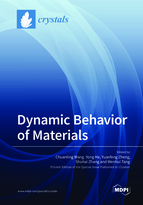Dynamic Behavior of Materials
A special issue of Crystals (ISSN 2073-4352).
Deadline for manuscript submissions: closed (31 October 2022) | Viewed by 26710
Special Issue Editors
Interests: reactive materials; high-velocity impact; plastic deformation
Special Issues, Collections and Topics in MDPI journals
Interests: terminal ballistics; high-velocity impact; detonation
Interests: terminal ballistics; reactive materials; shape charge effects
Interests: molecular reaction dynamics of explosive crystal; behavior co-crystals; detonation mechanism
Special Issue Information
Dear Colleagues,
The dynamic behavior of materials is a subject at the confluence of several scientific disciplines. The processes that occur when materials are subjected to rapid loads can differ significantly from those under static or quasi-static situations. The understanding of the dynamic behavior of materials involves the mechanics of high-strain-rate deformation (elastic, plastic, shock and detonation waves) and the dynamic response of materials (constitutive models, shear instabilities, microstructural evolution, dynamic fracture and chemical reaction).
This Special Issue, ‘Dynamic behavior of materials’, will collect recent research findings on the dynamic behavior of all kinds of materials, especially the dynamic mechanical behavior of crystalline materials. The main topics to be covered include processing technology, state-of-the-art characterization, testing, theoretic modeling and simulation. We welcome the submission of communications, original research papers, and reviews on the following, or related, topics.
- Microstructural evolution
- Dynamic deformation
- High-velocity impact
- Shock wave attenuation, interaction and reflection
- Equations of state
- Explosive–material interaction
- Impact-initiated chemical reaction
Dr. Chuanting Wang
Prof. Dr. Yong He
Dr. Yuanfeng Zheng
Prof. Dr. Shuhai Zhang
Prof. Dr. Wenhui Tang
Guest Editors
Manuscript Submission Information
Manuscripts should be submitted online at www.mdpi.com by registering and logging in to this website. Once you are registered, click here to go to the submission form. Manuscripts can be submitted until the deadline. All submissions that pass pre-check are peer-reviewed. Accepted papers will be published continuously in the journal (as soon as accepted) and will be listed together on the special issue website. Research articles, review articles as well as short communications are invited. For planned papers, a title and short abstract (about 100 words) can be sent to the Editorial Office for announcement on this website.
Submitted manuscripts should not have been published previously, nor be under consideration for publication elsewhere (except conference proceedings papers). All manuscripts are thoroughly refereed through a single-blind peer-review process. A guide for authors and other relevant information for submission of manuscripts is available on the Instructions for Authors page. Crystals is an international peer-reviewed open access monthly journal published by MDPI.
Please visit the Instructions for Authors page before submitting a manuscript. The Article Processing Charge (APC) for publication in this open access journal is 2600 CHF (Swiss Francs). Submitted papers should be well formatted and use good English. Authors may use MDPI's English editing service prior to publication or during author revisions.
Keywords
- advanced metallic alloys
- structural composites and hybrid materials
- materials for extreme in-service conditions
- multifunctional structural materials
- high pressure
- impact
- explosion
- plastic deformation
- microstructural evolution
- chemical reaction
- equation of state
- characterization
- modeling
- simulation










